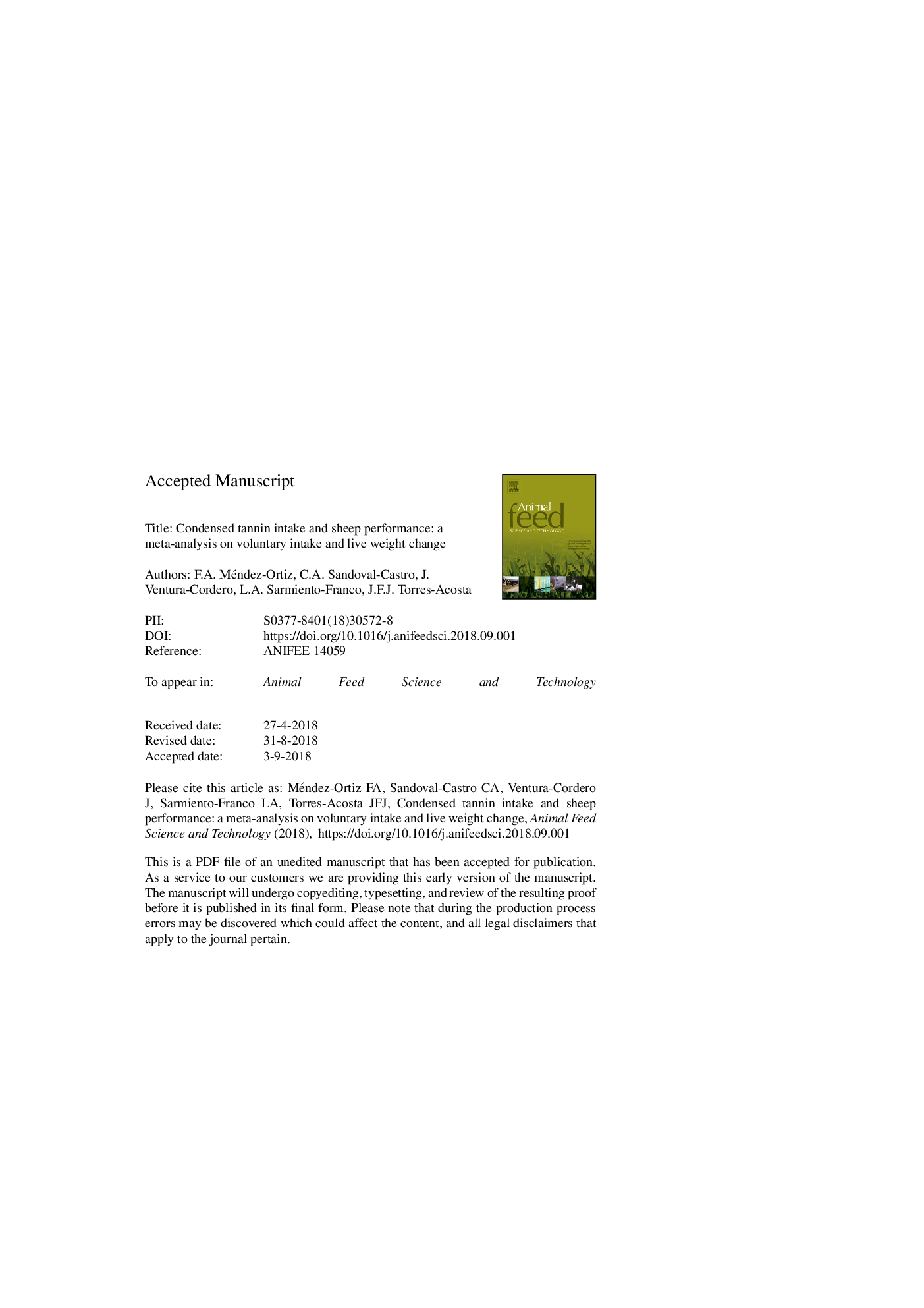| کد مقاله | کد نشریه | سال انتشار | مقاله انگلیسی | نسخه تمام متن |
|---|---|---|---|---|
| 11029282 | 1646558 | 2018 | 36 صفحه PDF | دانلود رایگان |
عنوان انگلیسی مقاله ISI
Condensed tannin intake and sheep performance: A meta-analysis on voluntary intake and live weight change
ترجمه فارسی عنوان
مصرف تانن و عملکرد گوسفند چگال: یک متاآنالیز در مورد مصرف داوطلبانه و تغییر وزن زنده
دانلود مقاله + سفارش ترجمه
دانلود مقاله ISI انگلیسی
رایگان برای ایرانیان
کلمات کلیدی
ADFINDFIDDMIOMDDCPILive weight changeNDFCTIDCPDMDOMIADFDMILWCcpd - CPDMEI - MAYNutritional requirements - الزامات تغذیه ایacid detergent fiber - الیاف پاک کننده اسیدMetabolizable energy - انرژی متابولیزه شدهCondensed tannins - تانن های متراکم یا تانن های فشردهneutral detergent fiber - فیبر مواد شوینده خنثیDigestibility - قابلیت هضمorganic matter - ماده آلیMetabolizable energy intake - مصرف انرژی متابولیزه شدهorganic matter intake - مصرف ماده آلیdry matter intake - مصرف ماده خشکOrganic matter digestibility - هضم ماده آلیdry matter digestibility - هضم ماده خشک مادهCrude protein digestibility - هضم پروتئین خامLive weight - وزن زندهcrude protein - پروتئین خامdigestible crude protein - پروتئین خام قابل هضم
موضوعات مرتبط
علوم زیستی و بیوفناوری
علوم کشاورزی و بیولوژیک
علوم دامی و جانورشناسی
چکیده انگلیسی
This study estimated the impact of condensed tannin (CT) consumption on dry matter intake (DMI) and live weight change (LWC) of growing sheep by means of a meta-analysis. A metabolic cost associated to CT intake was also estimated. Data included in the meta-analysis were obtained from scientific literature with the following inclusion criteria: (a) growing lambs fed ad-libitum without gastrointestinal nematode infection, (b) feed consumption data, (c) chemical composition of diets, and (d) CT consumption data. Data were analyzed as a whole data-set or grouped into three categories: (a) sheep consuming CT (CT group), (b) sheep not consuming CT (non-CT group) and (c) sheep consuming CTâ+âpolyethylene glycol (CTâ+âPEG group). The effect of diet composition and quality (crude protein (CP), organic matter (OM), neutral detergent fiber (NDF), condensed tannins (CT), metabolizable energy (ME), dry matter digestibility (DMD), OM digestibility (OMD) and CP digestibility (CPD)) on DMI (g/kg0.75) was evaluated using regression analyses. The effect of diet composition and consumption of those same variables (g/kg0.75) on LWC (g/kg0.75) were also evaluated using respective regression analyses. The metabolic cost of CT consumption was estimated in terms of digestible crude protein (DCP) and ME requirements. The cost was estimated for a diet to sustain maintenance and a diet to supply 100âg/d LWC requirements. No effect was found of CT intake on DMI or LWC (Pâ>â0.05). The DMI was best predicted by CP and DMD concentration (g/kg DM), when analyzed as a whole data-set. When analyzed as separate categories for CT and non-CT group was best predicted by ME (MJ/kg DM) (Pâ<â0.05). For the CTâ+âPEG group the DMI was best predicted by NDF (Pâ<â0.05). The LWC was best predicted by DCPI2 when analyzed as a whole data-set. The best predictor of LWC was the DCP intake (for the CT data) and the ME intake (for non-CT data and CTâ+âPEG data) (Pâ<â0.05). Although CT intake do not have an effect on DMI and LWC, it was observed that at low dietary CP level increases DCP requirement and hence it does have a metabolic cost associated. The metabolic cost of CT consumption estimated for animals consuming a maintenance diet was 0.33âMJ of ME/kg0.75 and 1.04âg of DCP/kg0.75 and for animals fed a 100âg LWC diet was 0.13âMJ of ME/kg0.75 and 0.87âg DCP/kg0.75. Thus, a higher cost for CT intake was found for groups of lambs at low feeding level and the metabolic cost was reduced when lambs were at higher feeding levels.
ناشر
Database: Elsevier - ScienceDirect (ساینس دایرکت)
Journal: Animal Feed Science and Technology - Volume 245, November 2018, Pages 67-76
Journal: Animal Feed Science and Technology - Volume 245, November 2018, Pages 67-76
نویسندگان
F.A. Méndez-Ortiz, C.A. Sandoval-Castro, J. Ventura-Cordero, L.A. Sarmiento-Franco, J.F.J. Torres-Acosta,
